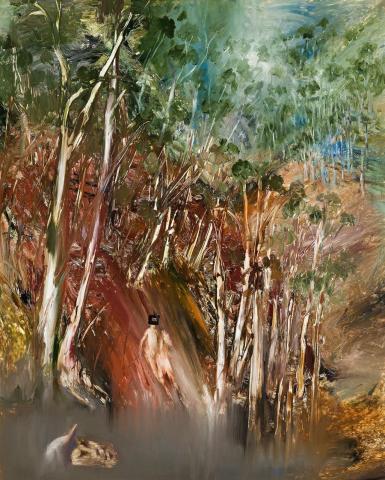RIVERBANK, 1964
Sidney Nolan
oil on composition board
152.0 x 122.0 cm
signed and dated lower right: N 25 Dec 1964 / Nolan¨label attached verso with artist's name, ¨title and Agnew’s stock no. CM6280
inscribed verso: Marlborough /No 2 / Riverbank / Nolan / 1964
signed and dated verso: 25th Dec / 1964 / Nolan
Marlborough Fine Art Ltd, London
Private collection, London
Agnew's, London (label attached verso)
Private collection, Sydney
Sidney Nolan: Recent Work, Marlborough Fine Art Ltd, London, May 1965, cat. 2, as 'River Bank'
In late 1964, Sidney Nolan returned to the subject of Ned Kelly, painting a series of pictures of Kelly in the Australian landscape which, in turn, led to the mighty Riverbend I, 1964-65, the first of his great polyptychs. While this nine-panelled tour de force, now in the collection of the Australian National University, Canberra, captures much attention, the earlier, separate paintings, offer a fascinating insight into their evolution.1 Nolan dated each painting on the verso, as in Riverbank and the separate panels of the polyptych, allowing the viewer to participate with the artist in their daily creation. Waterfall, for example, was painted on 23 December 1964, Riverbank on Christmas Day, and Kelly and Horse completed on Boxing Day. The first of Riverbend panels was painted on 27 December, the last panel being dated '14 Jan 1965'.
Paintings such as Riverbank and Riverbend are regarded by Nolan cognoscenti as among his best Kelly works. Robert Melville, writing in the catalogue introduction to their London exhibition of 1965, noted the several times and styles in which Kelly appeared in Nolan's art, and found 'in these latest works (which I find among his best)' the same theme - 'the portrayal of the defiant, avenging outlaw, who is haunted by his destiny but who is still determined to go on with his private vendetta against the world until the bitter end.'2 The grandeur of the landscape setting, the river and its tall gums, was drawn from Nolan's boyhood - the Goulburn River near Shepparton, and the Murray. Stillness is all pervading, blending with a haunting silence as Kelly, naked, centaur-like, emerges from the waterfall in virile, mythic splendour. Crowned with his iron mask, its man-made, stark blackness contrasts with the surrounding natural forms and floating ghostly visage of Constable Scanlon. Through the creative and poetic imagination of Nolan's genius, the brutality of the historic episode is transformed into the elegiac.
Nolan visited Antarctica at the beginning of 1964, the paintings of his experience there continuing the theme of man isolated against the might of nature. The tribulations of Burke and Wills are replaced by the unimaginable terrors experienced by Robert Falcon Scott and his companions. When these Antarctic paintings were shown together with the Kelly paintings at London's Marlborough Fine Art, Melville observed that 'The human being is a midget in these vast spaces, and he can be blotted out in a moment.'3 However, in Riverbank and its companion paintings, Nolan raises the subject of man in the landscape to another level. He is now an integral, not alien, part of the scene. In this moment of apotheosis, Kelly and Scanlon are seen as god-like images from the ancient mythology of the Great South Land.
1. Another version, Riverbend II, 1965-66, is in a private collection in New York
2. Melville, R., 'The Poetry of Painting', Robert Melville, Sidney Nolan: Recent Paintings, Marlborough Fine Art Ltd, London, 1965, no pagination
3. ibid.
DAVID THOMAS
